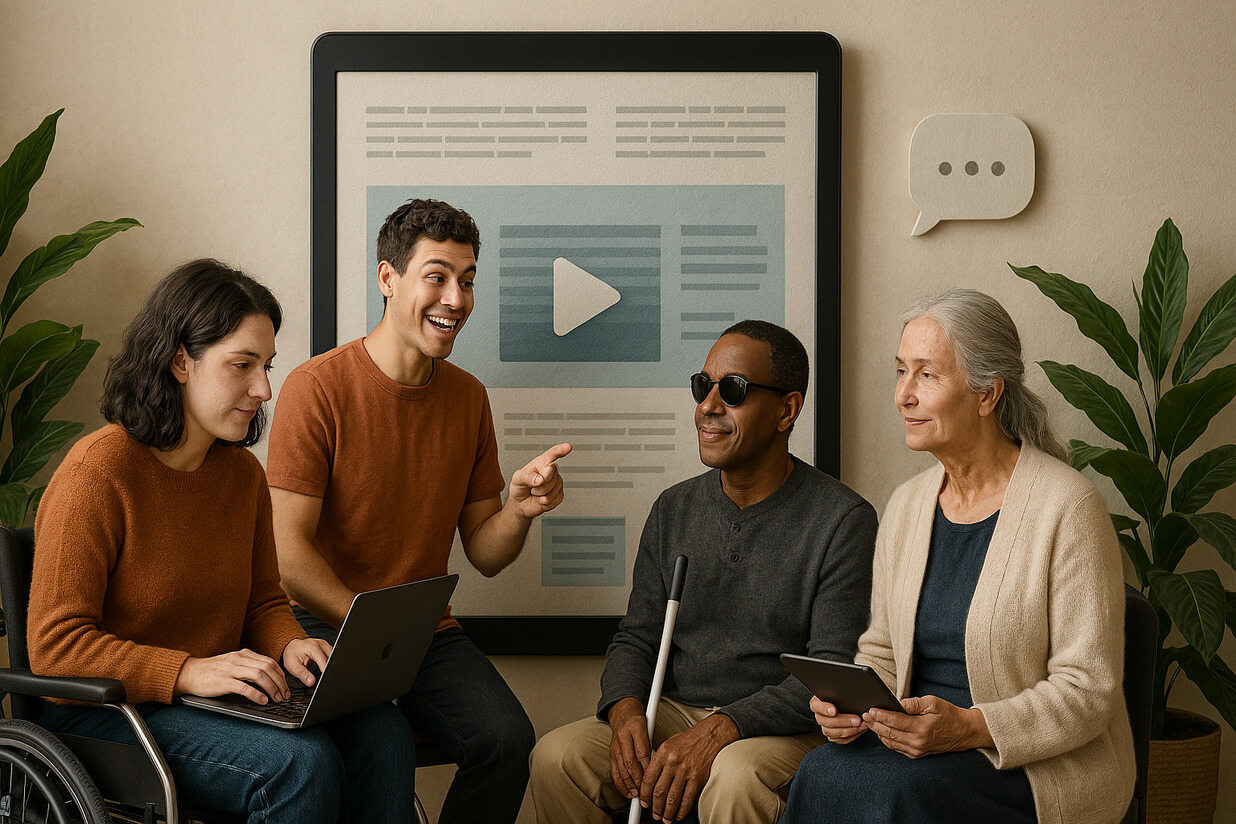
Storytelling for All: Why Accessibility Matters
Storytelling has always been a bridge between people, cultures, and generations. In the digital space, it has the power to reach wider audiences and preserve stories for future generations. However, not everyone has the same access to digital tools or the ability to engage with content in the same way. Digital storytelling must be inclusive, ensuring that people of all abilities and backgrounds can participate, create, and experience meaningful stories.
Creating an accessible storytelling experience goes beyond adding captions or transcripts—it requires thoughtful design, diverse formats, and adaptable platforms. By addressing barriers such as visual, auditory, cognitive, and technological limitations, storytellers can ensure their work reaches the broadest possible audience. When accessibility is prioritized, stories become more engaging, meaningful, and impactful for all.
This article outlines key strategies for making digital storytelling accessible. From choosing the right tools and designing for different abilities to promoting inclusivity through diverse perspectives, these steps will help ensure that digital narratives are truly for everyone. Whether you’re a content creator, educator, or business professional, making storytelling more inclusive strengthens connections and enriches the digital world.
Why Accessibility Matters in Digital Storytelling
Digital storytelling is more than just a creative outlet—it shapes how people share experiences, learn, and engage with the world. When content is not accessible, entire communities are excluded from participating in these shared experiences. Addressing accessibility ensures that stories can be understood, appreciated, and enjoyed by all.
Many individuals face barriers when engaging with digital content. People with visual impairments may struggle with image-heavy content, while those with hearing loss may miss key information without captions. Cognitive and motor disabilities can also make it difficult to navigate websites or interact with multimedia content. Designing with accessibility in mind removes these obstacles and creates an inclusive space for storytelling.
Beyond inclusivity, accessible digital storytelling improves overall user experience. Features such as clear navigation, readable fonts, and multiple content formats benefit everyone, not just those with disabilities. By making accessibility a core part of digital storytelling, creators build stronger, more engaged audiences and ensure that their messages reach the widest possible group.
Choosing the Right Digital Storytelling Platforms
Selecting a platform that supports accessibility is a crucial step in making digital storytelling available to all. Some platforms offer built-in tools that enhance usability, while others require additional modifications to ensure inclusivity. Evaluating these options helps storytellers create content that can be experienced by diverse audiences.
For video-based storytelling, platforms like YouTube and Vimeo offer auto-generated captions, though manual adjustments are often needed for accuracy. Social media platforms such as Instagram and TikTok now include captioning tools, but not all features are universally accessible. Websites and blogs, which allow for flexible content formats, must incorporate accessibility features like text-to-speech compatibility, screen reader-friendly layouts, and adjustable font sizes.
Interactive storytelling platforms, including podcasts and virtual experiences, require additional considerations. Providing text transcripts, ensuring voice clarity, and including alternative navigation methods improve usability. By choosing platforms that prioritize accessibility, storytellers can reach broader audiences and make their content truly inclusive.
Designing for Visual and Auditory Accessibility
Ensuring that digital stories are accessible to individuals with visual and auditory impairments is essential. Simple adjustments in design and multimedia presentation can significantly improve usability and comprehension.
For visually impaired users, alternative text descriptions (alt text) for images and graphics provide context when using screen readers. High-contrast color schemes, resizable text, and clear typography enhance readability. Avoiding small fonts, cluttered layouts, and excessive animations helps maintain accessibility without overwhelming users.
For those with hearing impairments, captions and transcripts should accompany all audio content. Captions should be accurate, synchronized, and include non-verbal audio cues when necessary. Transcripts should be easy to find and formatted for readability. Providing multiple ways to consume content ensures that storytelling remains engaging and accessible to all.
Making Interactive Content Inclusive
Interactive storytelling, such as virtual reality (VR), augmented reality (AR), and interactive web experiences, offers exciting ways to engage audiences. However, these formats can pose accessibility challenges that need to be addressed early in the design process.
VR and AR content should include multiple ways for users to engage. Providing voice commands, haptic feedback, and adjustable speed settings allows individuals with mobility challenges to interact with the content more easily. Ensuring that environments are not overly complex or motion-heavy also reduces barriers for those with sensory sensitivities.
Web-based interactive storytelling should incorporate keyboard navigation, screen reader compatibility, and customizable user settings. Features such as adjustable playback speeds, multiple language options, and simplified modes can make interactive experiences more inclusive. By thinking about diverse needs, storytellers can create immersive and accessible digital narratives.
Using Text-Based Storytelling for Greater Accessibility
Text-based digital storytelling is one of the most accessible formats, but it still requires thoughtful design to ensure inclusivity. The way text is presented can determine whether a story is engaging or difficult to read for certain audiences.
Providing multiple text formats helps accommodate different reading preferences. Offering downloadable PDFs, structured web pages, and audio versions ensures that users can choose the format that suits them best. Read-aloud features and braille-compatible files can further support users with visual impairments.
Additionally, using simple language and clear organization benefits all readers, including those with cognitive disabilities or limited language proficiency. Well-structured content, headings, and summaries allow readers to navigate stories easily. Making digital storytelling text-friendly helps ensure that narratives are accessible to a wide audience.
Ensuring Digital Storytelling is Culturally Inclusive
Beyond technical accessibility, digital storytelling should also reflect diverse voices and perspectives. Representation matters, and inclusive storytelling ensures that all audiences see themselves in the narratives being shared.
Using diverse voices and experiences in storytelling creates richer, more meaningful content. Engaging with contributors from different backgrounds helps ensure authenticity and avoids unintentional biases. Stories should reflect a range of cultures, languages, and lived experiences to foster genuine connection.
Translation and localization options also improve accessibility. Offering multilingual content, subtitles, or alternative versions allows non-native speakers to engage fully. By prioritizing cultural inclusivity, digital storytelling becomes a tool for global connection and understanding.
Providing Multiple Ways to Access Content
People engage with stories in different ways, and offering multiple content formats ensures that digital storytelling is accessible to a broader audience. By providing alternative ways to consume information, storytellers make their narratives more inclusive.
For visual content, including both text-based descriptions and audio alternatives allows users with different needs to engage. Videos should have captions, podcasts should have transcripts, and images should include descriptive alt text. These small adjustments make a significant difference in accessibility.
Additionally, allowing users to customize their experience improves engagement. Features such as dark mode, adjustable text sizes, and optional autoplay settings enable audiences to interact with content in a way that suits their preferences. Digital storytelling should adapt to the audience, not the other way around.
The Future of Accessible Digital Storytelling
As technology continues to evolve, digital storytelling must grow alongside it to remain accessible. New innovations offer exciting possibilities, but they also present challenges in ensuring that all users can benefit.
AI-driven captioning, real-time translation, and adaptive interfaces are making digital storytelling more inclusive than ever. However, accessibility must remain a priority in content creation. Testing new technologies with diverse audiences and gathering feedback helps ensure that innovations serve everyone effectively.
The future of digital storytelling depends on inclusivity. By committing to accessibility now, creators can shape a digital world where every story has the power to reach, inspire, and connect.

